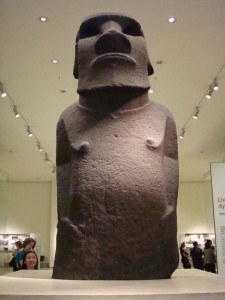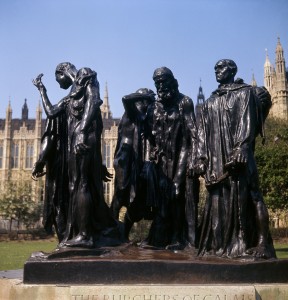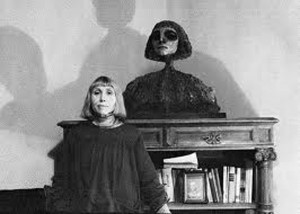Through a letting agency I found a basement flat to rent in West Kensington. It was in the middle of Castletown Road, where most of the large four or five storey houses had been converted into flats and occupied by tenants who had come from other places – the West Indies, Poland and from the Middle East. The street had a business end (towards North End Road), market stalls and West Kensington Station. I think Honor Blackman had a flat there. The other end was the ‘posh’ end, quieter and close to Baron’s Court Tube, not far from the Queen’s Club (Tennis and Rackets).
Weekdays I took the Tube to College, straight into South Kensington. At weekends I would go by bike down to the Kings Road, along to Sloane Square and the Clark’s studio, where I was a sculptor’s assistant. I enjoyed riding my bike in London at that time, and without a helmet I was lucky to remain intact. My bicycle however, was less fortunate. Late one evening, having been for a drink in a local pub with Alan and Joan, we were chased back to our flat by a group of younger men. We scurried down the steps into 50A. Both women were pregnant and as husbands we were acting to protect them, from what? Of course had it not been for our wives’ condition Alan and I would have faced the layabouts and told them where to go. However, discretion being the better part of valour, we considered our options, safe behind the locked and bolted front door. My lovely green bicycle had been left carelessly leaning against the railings, did I ever learn? It came crashing down the stairwell, damaged but repairable.
Some months later, outside the Post Office in North End Road, the bike suffered the indignity of being crushed, on this occasion by a lorry reversing into what the driver had thought to be an empty space. This time it was mangled beyond mending, a disaster that put an end to my cycling in London.
In our basement flat I remember the living room off a long dark hall. It was painted a la mode with the new-fangled emulsion paint: three walls brownish white called Mushroom and one wall whitish brown called Mocha. The kitchen was off to the right at the end of the hall. There must have been at least one bedroom to the left, but I can’t remember it.
The kitchen walls were painted ‘Kensington Cream’ and in the kitchen there was a hipbath, hidden away most of the time in a hardboard cupboard, perfect for bathing a baby.
At the end of the hall corridor stood a plaster torso, a copy of a Greek sculpture in either the British Museum or the V&A. Jasper McGill, a student at College had given it to me, a reward for being his helper. Late one dark night, sitting on the back of McGill’s motorbike, I cradled a hot Vinamould boiler to Victoria Tower Gardens on the Embankment. Here we hurriedly poured the melted rubber into a plaster case to make a mould of part of the head of Jean D’Aire, one the six Burghers of Calais. Against the cold bronze the Vinamould set quickly and we were soon back on the bike to return to the Sculpture School in Queensgate. From this new mould we made casts in plaster and distributed them to fellow sculpture students. We all had a part of Rodin’s great masterwork, which is itself one of 12 casts made from the original. The Burghers of Calais is a monument depicting those volunteers who had offered their lives to Edward III, in 1347 during the Hundred Years War when Calais was under siege by the English. Six notables making the ultimate sacrifice to save their city from annihilation – finally they were spared the hangman.
We lived in our home for a couple of years from August 1959 onwards, and with baby Christopher from March until September 1961. It was an eventful period that included Graduation, my Rome Scholarship and a baby. When we left our little abode I forgot to dig up a terracotta head that I had some time before buried in the garden, hoping for an antique patina!
While at the RCA (from Year 2 until Year 4) and living in Castletown Road, I worked at the Clark’s studio in Sloane Square on Friday afternoons, on Saturdays and Sundays. I had taken over Hughie’s job who, when he left the RCA, returned north to marry Joyce and, I trust, live happily ever after with a large family. Hughie was a good friend in my formative years.
Usually on Monday mornings I would go very early to College to make up for the afternoon hours taken off on a Friday to work for Michael Clark, sometimes I returned to Queensgate on Friday evenings to carry on with work. The studios were open until 10.
Occasionally I was asked for by Prof Meadows, but my truancy was never discovered. This was thanks to John Clinch who covered for me.
“He was here a minute ago,” he’d say,” or “I think he’s in the workshop.”
Meanwhile I kept my job, weekends in term time that became weekdays during the Christmas, Easter and Summer vacations.
Almost all the Clark carvings were made from stone, rather than wood. We used Ancaster, Clipsham, Portland and Bath stone. The Stations of the Cross were a regular commission; fourteen Relief tablets representing the journey of Christ from the Garden of Gethsemane, to his Crucifixion and final resting place in a tomb. The prototypes for Michael Clark’s Stations were the great Gill carvings in Westminster Cathedral, just around the corner from the studio. In fact Eric Gill was influential also in the way the studio was run as well as the work being made within it. Michael Clark had a bushy beard and dressed for sculpture in a brimless hat and an apron, but not a smock. He worked five days a week in the Sloane Square studio, sleeping in the tiny office and going home to the country on Friday afternoon to be with his wife and seven children for the weekend.
In a roundabout way it was through Josef Herman that I met Vida Jocic. There was a small community of artists in that area of West Kensington, Josef himself lived in Edith Grove, one street up from me. He asked me to help Vida make copies of a sculpture – a facemask – for her forthcoming exhibition at the Grabowski Gallery. Mateuz Grabowski had established his Gallery in 1959 next door to his pharmacy in South Kensington.
One weekend I (again) borrowed the Vinamould Boiler from College and set to work in my kitchen to make a plaster case to contain the hot-melt compound. Then I poured it over Vida’s work. From the resultant impression of the original I took six plaster casts.
I remember I charged a pound for each one. I was very reluctant to take the money when I saw 49865 tattooed inside Vida’s left forearm – blue numerals that made me shiver. No wonder Vida was an intense and nervous woman. I had met someone whose experience was far beyond my comprehension or my imagination and I wanted to run from that encounter.
The evidence of her pain and suffering was too apparent for me to deal with.
“If there was ever hell on Earth, it was Auschwitz”


